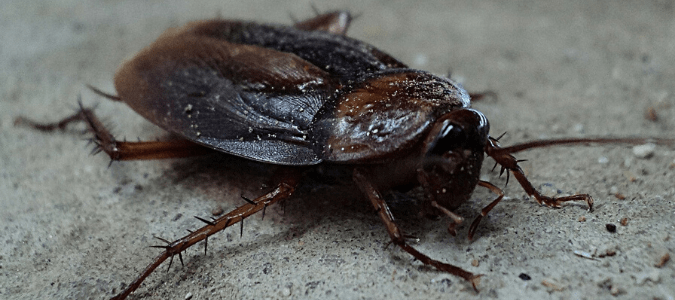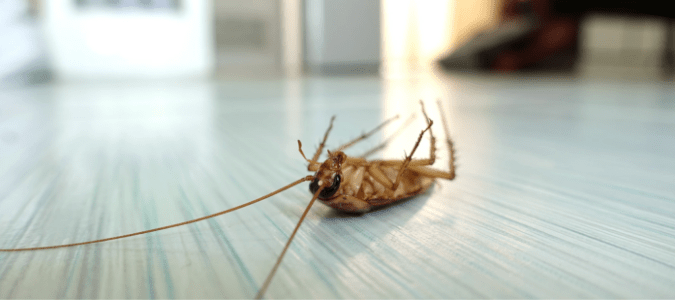When you spot a bug running across the floor, you may wonder what exactly you just saw. Yes, it’s the old cockroach vs. beetle debate: Was that some type of beetle? Most of us don’t want beetles in our houses, but at least they don’t have quite the ick factor that cockroaches have. Or was it—shudder—an actual cockroach? Fortunately, there are several distinct characteristics that can tell you which insect you just saw, even if you only spotted the pest for a second before it zoomed out of sight. (Hint: If it looked like the image above and it moved that fast, it was most likely a cockroach.)
Identifying the Differences Between American Cockroaches, Oriental Cockroaches and Beetles
There are several main types of cockroaches that people commonly find in their homes. Two of them look very similar to each other, namely American and Oriental cockroaches. Both of these types of roaches grow to be pretty large—an inch and a half to two inches long and a half-inch wide. American cockroaches are a medium to dark reddish-brown color. Meanwhile, Oriental cockroaches are so dark brown they’re almost black. American cockroaches have wings and sometimes seem to fly. That said, they’re more likely to glide by spreading their wings and launching from a high-up spot to reach a lower one. Oriental cockroaches do not fly.
Some types of beetles do look similar to American and Oriental cockroaches. They can grow to be about the same size and color, and they might also have wings, like American roaches. Certain types of ground beetles look a lot like cockroaches, and Junebug beetles can look like younger cockroach nymphs.
There are some notable differences between cockroaches and beetles, though. Beetles have segmented bodies, while cockroaches’ bodies are oval-shaped and flat. And unlike cockroaches, beetles have big pincer jaws along with hard exoskeletons.
Furthermore, beetles are typically slower-moving than cockroaches. Roaches can zoom along at several miles per hour. For many people, it’s their sheer speed that makes cockroaches so scary—not to mention so hard to whack with a shoe when you see one. So if you spot a quick-moving bug in your home and you aren’t sure whether it’s a cockroach or a beetle, it’s probably a roach.
Identifying the Differences Between German Cockroaches and Beetles
German cockroaches are smaller than American and Oriental roaches. They grow to only about a half-inch long and are a paler brown color. Some people might confuse German cockroaches with beetles even more easily than larger roaches due to their size and color.
It’s common to mistake a German roach for a Junebug or a click beetle, for example. Even though both Junebugs and click beetles have harder exoskeletons than German roaches. Junebugs are also a more golden-brown color than German cockroaches, with more rounded bodies. On the other hand, click beetles have narrower, more segmented bodies than German roaches, and are darker in color.
Beetles also typically don’t infest a house the way various types of roaches do. If you see a beetle inside your home, it probably wandered in from outside, the same way American and Oriental cockroaches do. (German roaches don’t live outdoors, so they don’t wander in from outside. Rather, they are typically brought into people’s homes by way of egg cases that are stuck to items like furniture, books, clothes, grocery bags or boxes.)
Unlike roaches, a beetle or two in the home usually doesn’t indicate a full-blown infestation, although it can. Certain types of beetles do infest people’s homes, such as carpet beetles. These small, rounded, brown or black beetles lay eggs on people’s furniture and carpets. These pests can ruin anything made of fabric, chewing through rugs, upholstery, clothing and bedding.
Carpet beetles do not look much like cockroaches, and roaches are far more likely to infest a home. Unfortunately, seeing just one cockroach in your home can be a sign of an infestation. This is especially true of German cockroaches. Unfortunately, they are also one of the hardest pests to get rid of. Female German roaches can lay tens of thousands of eggs in their lifetime. These pests are incredibly prolific. This is why their numbers can grow out of control if they aren’t professionally treated.
Spotting the Signs of Cockroach Infestations
Seeing roaches in the home isn’t the only sign of a cockroach infestation, of course. There are other signs to look for, such as cockroach feces—little brown specks that look either like bits of dirt, or like tiny brown drips and smears. These are usually found on countertops, inside cupboards, or on baseboards or wallpaper.
Another sign of a cockroach infestation is spotting cockroach egg cases anywhere in the home. These are small, brown or black cases with hardened, sometimes banded exteriors. A single case can hold 30 to 50 eggs, depending on the type of cockroach. Again, it’s easy to see why cockroaches can take over a home if an infestation isn’t treated properly.
If you’re wondering whether your home has a cockroach or beetle problem, it’s a good idea to reach out to a pest control specialist. A specialist can identify the exact type of pest you’re dealing with. That will help them determine the right products and treatment methods to get rid of the pests as quickly and thoroughly as possible. This way, you can breathe easy in your home once again. A reputable pest control specialist will also set up an ongoing pest control schedule with you to ensure they stay on top of future pest problems before they get out of control.
Do Cockroaches Carry Disease?
Many people wonder, do cockroaches carry disease? Well, cockroaches don’t exactly carry and transmit disease in the same way that rats or raccoons can. However, roaches can make people ill in a couple of different ways.
First, cockroaches carry bacteria. In most homes with a cockroach infestation, the kitchen is one of the main areas of cockroach activity. Roaches might spend time on the counter or stovetop, in the pantry and inside cupboards that hold dishes. These are all areas that people touch frequently or where food is eaten or prepared. Wherever roaches are, they can contaminate the surfaces they touch, including your food itself. In this way, cockroaches have been connected to diseases like salmonella, staphylococcus and streptococcus.
The second way that cockroaches can make people sick is through shedding their exoskeletons. These exoskeletons have been linked to asthma, allergies and respiratory issues in humans. If you have asthma or allergies, or you live with someone who does, it’s important to keep roaches at bay in your home so they don’t make your health issues worse.
Trying to battle a cockroach infestation on your own can take a long time and cause lots of worry and frustration. Unfortunately, in many cases it also prolongs the problem and ultimately doesn’t work. For most people, the quickest, most thorough way to combat roaches is by hiring a pest management professional. A professional can inspect the home, determine the type of cockroaches present, find their nest and use the best products and techniques to control these pests.
Does Natural Cockroach Repellent Work?
Some people with cockroach problems in their homes are worried about using insecticide products. But, does natural cockroach repellent work? There are certain natural cockroach repellents that have shown some effectiveness. One example is boric acid, which is considered safe to use in the home as long as you don’t use it in places where pets and children will come into contact with it.
The problem with natural cockroach repellent products is that they aren’t effective enough to combat a full-blown cockroach infestation. They work best when they’re used in tandem with professional roach treatments. For example, you can spread boric acid around your kitchen all you like, but the roaches will keep coming back if you don’t also keep your kitchen clean, store your food in well-sealed containers and take steps to seal off any little gaps or holes that roaches use to get inside your home.
The best pest control strategy is one that is one that uses several different approaches together to get rid of roaches. In the case of cockroaches, an effective, multi-pronged pest control plan will include:
- Keeping your kitchen clean, wiping up spills, crumbs and splatters so they won’t attract roaches.
- Keeping indoor trash, recycling and compost items in roach-proof bins, and emptying them regularly.
- Storing all food, including pet food, in airtight containers that roaches can’t access.
- Putting pets’ food and water bowls away at night, when roaches are most active and may be attracted to them.
- Fixing leaky faucets and pipes, or any other source of water indoors that roaches might use to survive.
- Setting out boric acid, cockroach baits, or other roach repellent or insecticide products.
- Hiring a reputable pest control specialist to schedule regular pest inspections and treatments of your home. This can keep roach populations low both indoors and outside.
Using all these strategies together will kill off roaches if you have an infestation. It will also help to keep them from infesting your home again in the future.
ABC Can Create a Thorough Roach Treatment Plan For Your Property
Dealing with a cockroach problem can feel like an exhausting, neverending task. Instead of attempting home remedies, contact ABC Home & Commercial Services. Our highly trained professionals will create an effective pest treatment plan, so you don’t have to worry about any more creepy crawlies.


